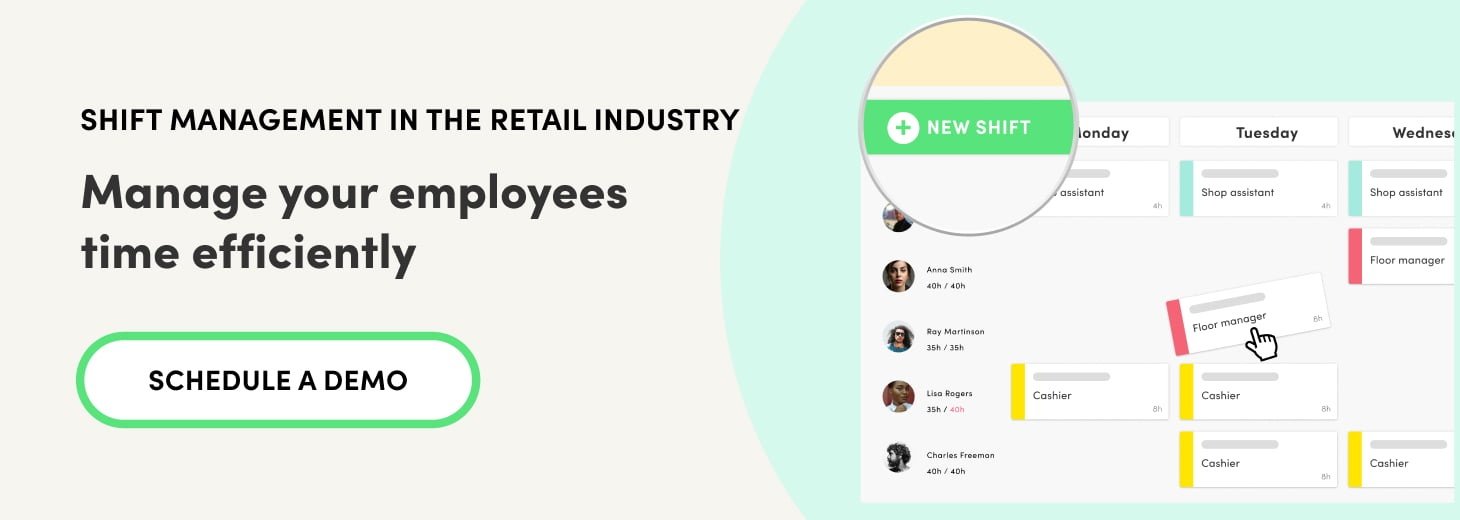The biggest impacts of job absenteeism in retail
%20(1).jpg)
Employee absenteeism in retail has a huge impact on companies, with both financial and operational consequences. It also means a lot of extra work for the HR team, who need to look for alternatives to cover the hours an employee is absent.
It can also generate a negative atmosphere within teams, especially when it concerns unauthorised absences, which translates into poor customer service. For this reason, it is essential to put strategies in place to manage teams effectively and avoid high levels of absenteeism in the retail sector.
In this article, we explain some of the causes and consequences, and the tools that can help you reduce absenteeism.
Key figures on absenteeism in retail
In the retail sector, the statistics on absenteeism paint a concerning picture. According to a white paper by Kronos, a whopping 13% of work hours are being wasted. There is also a considerable impact on retailers' work budgets due to unplanned absences. The paper shows that 7% of work hours are scheduled but not worked, while 6% are worked but not scheduled.
On a global scale, a survey by the Workforce Institute with 800 managers from the retail sector showed how in the UK, 74% of those surveyed confirmed they are short staffed more than 25% of the time due to last minute absences. These statistics are higher than those of Canada (72%), France (71%), Germany (69%), Australia (64%) and the US (61%).
Equally, 52% of the companies surveyed ranked absenteeism in the retail sector as the most difficult problem to resolve, and the one that takes the most time; something that reflects a structural trend that companies need to address.
The causes of employee absenteeism
By looking into the reasons why workers are absent from their jobs, we can get to know our employees better, understand their needs and find the best solutions to resolve the situation.
The main causes of absenteeism in the retail sector have a lot to do with stress and lack of motivation at work, according to various studies carried out by staff management companies. Equally, the characteristics of each position and the work environment at the company also have a considerable impact on absenteeism rates.
Most causes fit into one of the following groups:
Causes relating to employees
Occasionally, the main reason for absenteeism is due to causes outside the organisation which have to do with the employee themselves. These are some of the most common reasons in this section:
- Medical and healthcare absences
This type of absence occurs when the worker needs time off to attend an appointment or undergo a medical procedure, or requests sick leave due to a temporary illness.
- Family and personal reasons
Sometimes employees are absent from work stating family reasons such as caring for children or a dependent. These reasons can also be of a personal nature, for example if the employee is unavailable for emotional reasons or when they do projects alongside their main job.
- Force majeure reasons
In this case, the worker claims incidents such as weather issues or a transport network failure prevented them from showing up for work.
- Stress and demoralisation
Stress and demoralisation are two factors that can have a considerable influence on absenteeism rates. A lack of engagement with the organisation or with the purpose of the work the employee does are frequent reasons for high levels of absenteeism.
As well as affecting the business as a whole, it is also something that can precipitate a toxic environment and lead to a loss of trust within teams.
Causes relating to the company
- High workload
Occasionally, a high workload or burnout from dealing with customers, can cause employees to feel more dissatisfied and stressed, which leads to unauthorised absences.
- High staff turnover
If there are constant team changes caused by employees leaving or new starters joining, it can result in a negative company climate for workers.
High turnover in teams not only means you have to find cover for the positions and shifts of absent colleagues, but also that the staff never manage to adapt as a work team and there is little integration of new starters, resulting in a fragmented social atmosphere in the company and elevated employee absenteeism.
- Accidents and risks in the workplace
When an employee suffers an accident at work due to the risks involved in their profession, absences are for the most part authorised.
- Lack of leadership and bad management
A lack of leadership from managers and team leaders can lead to poor management, creating demoralisation and low engagement among employees.
- Negative work environment
If the company suffers from a negative work atmosphere among colleagues or between superiors and other staff, this can become a structural problem that will have an impact on the number of absences. It is therefore vital to analyse the company work environment and evaluate it using staff satisfaction questionnaires.
The consequences of high rates of absenteeism
Absenteeism in the retail sector has notable consequences, including low productivity, lack of organisation and trust, and increased costs for the company.
For this reason, it is important to identify those that happen frequently, analyse them, and implement appropriate solutions to avoid these situations.
Disorganisation
When an employee tells us at the last minute that they will not be coming into work, or they simply don’t show up, this has repercussions on the company’s organisation in general, above all on shifts that have already been allocated. It also means the HR department needs to look for a replacement or that their colleagues will have to cover the absence.
Customer service can also suffer due to there being fewer staff than planned, leading to an unexpected workload.
Lack of trust
Continued, unauthorised absences by an employee makes us lose trust in them, above all in their professionalism. If we don’t know if we can rely on their work, this generates an atmosphere of uncertainty, a fact that also affects the team around them who will notice changes to their routines and volume of work.
Furthermore, if the organisation does not act promptly, it can also produce a feeling of discontent towards HR managers, the ones responsible for avoiding that situation in the first place.
Poor customer service
Unjustified absenteeism translates into deteriorating customer service, affected by staff shortages and the need to improvise when an absence takes place without advance notice.
As well as having a direct repercussion on service standards, it can also lead to loss of customers, affecting the business volume and leading to a generalised decline in benefits.
Loss of productivity
If an employee has to do the work of two people as a result of a colleague’s absence, their productivity will be halved, and most likely quality will suffer.
This can jeopardise the achievement of set goals and generate a work environment in which workers feel demoralised and productivity suffers.
Cost increases
Employee absenteeism goes hand in hand with certain costs that the company will need to cover. According to a report by Westfield Health, the costs of mental health related absenteeism alone rose by 10% during the pandemic, which cost UK businesses £14 billion last year.
In this context, we need to distinguish between direct costs – those that cause immediate losses – and indirect – which affect different areas of the business as a result of absenteeism. We can group the relevant costs as follows:
Direct costs:
- The absent worker’s salary
- Paying replacements
- Overtime pay
While absences due to sickness may not incur the full salary depending on the company’s sickness policy, companies must pay Statutory Sick Pay (SSP) of £96.35 a week from day 4 of an illness up to 28 weeks.
Indirect costs:
- Costs of replacing staff
- Tax and National Insurance
- Loss of benefits
- Reduction in product quality and services offered
- Administrative costs
How can technology help to reduce absenteeism?
Technology can be a great help when trying to reduce job absenteeism, as it enables us to analyse the causes and consequences of the issue. It provides a useful overview for the HR department and other areas responsible for addressing absences, particularly when they are unauthorised or generalised, and can also help to implement solutions.
So, HR software is a tool that automates the collection of data relating to absences and helps to prevent them. Below, we will highlight some of the most relevant features for combatting job absenteeism:
- Attendance: this tool allows you to plan work shifts and staff schedules, while employees record their start and finish times and remote working days.
- Time off: you see at a glance which employees have authorised absences, due to holidays or sickness, allocate leave and automatically approve requests.
- Staff satisfaction survey: obtain clear, accurate information about what your company environment is like via surveys you can use to study team engagement and productivity. You can also provide and receive feedback from your employees to help them grow professionally.
- Performance review: monitor teams in detail to identify each person’s talent and recognise individual work.
At Kenjo, we give you the chance to test these and other employee management features with our software free trial. With our software, you can ensure more efficient and agile management of staff and administrative tasks, and reduce the HR department’s workload.



